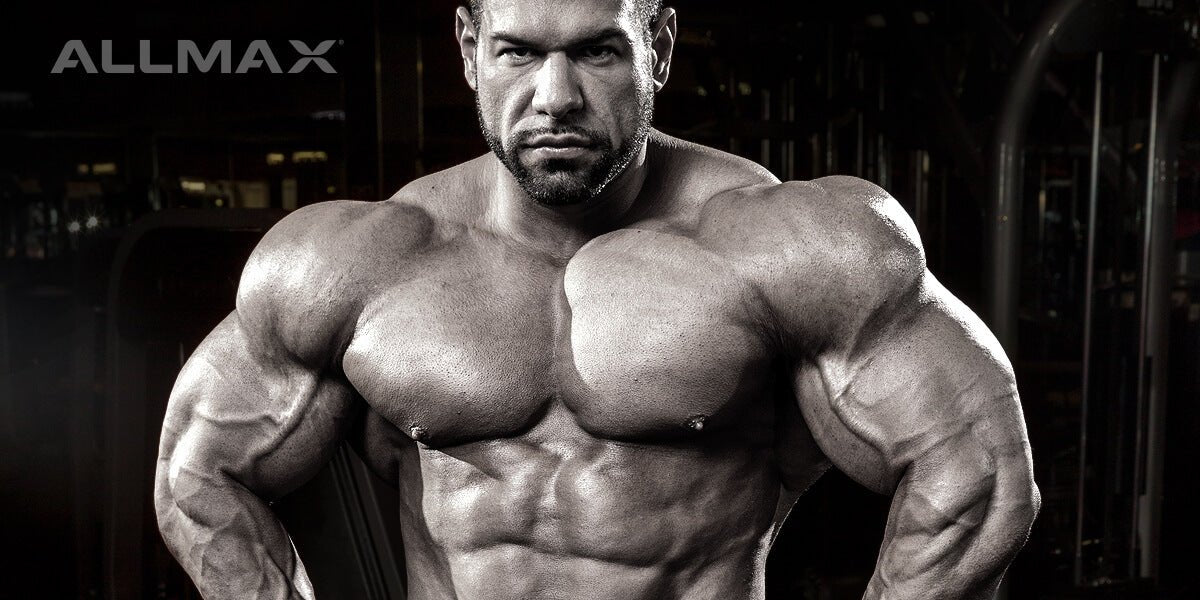A lot of people know they should prioritize chest workouts but wonder how the decline bench actually activates the lower pectoral muscles and whether or not it’s a worthwhile fitness move. ALLMAX has all the details on the decline bench press, what does the decline bench work and why it’s a fantastic lower chest workout.
Decline Bench Press Basics
Adding the decline bench press to a workout routine can make a big difference, especially for those trying to get a stronger chest. It’s long been a go-to move for both fitness fanatics and those just starting out on their gym journey, and once you get down to it, it’s easy to see why.What Is the Decline Bench Press?
The decline bench press is one variation of the traditional bench press, done laying flat at a level height. With a decline press, the bench is positioned at a 15 or 30-degree downward angle so the lower pectoral muscles are engaged as weight is pushed up and away from the body.Decline vs Incline Bench Press?
A bench press can be done with the bench laying flat, at a decline or at an incline. While the flat bench press works the triceps and pectorals, an incline bench press is similar to a shoulder press and targets the upper portion of the pectorals. As the name suggests, a decline bench press has the chest at a downward angle, while the incline bench press uses an upward position.What Are the Main Decline Bench Press Benefits?
A bigger, better body awaits thanks to the intense way in which the decline bench press works the lower chest. The main benefits of a decline bench include activating the lower pecs and giving the triceps, biceps and front shoulder muscles a good workout. With the decline press, there’s less stress placed on the shoulders and back, as the lower pecs work harder in this angle. When pressing downward, the lower pecs and front shoulder deltoid keep the arm flexed, with support from the biceps. In the upward phase, the lower pecs, triceps and shoulders do the heavy work.Who Should Do the Decline Bench Press?
Males and females, beginners and advanced fitness gurus can all do the decline bench press. There are many ways to modify bench press workouts to suit an individual’s comfort level and strength. Slow and concentrated presses ensure safety and real results in the gym.Decline Bench Press Workout
Ready to work those lower pecs? Here is a go-to decline bench press workout trusted by those who are dedicated to their gym game. Just follow these steps for a high-quality decline bench press.- Set the bench at a 15-30 degree decline.
- Place feet at one end of the bench and lie face up with eyes straight underneath the barbell.
- Have palms facing forward for a solid grip on the bar, with arms positioned apart just slightly more than shoulder-width.
- Straighten arms to lift the barbell up and out of the rack. Bring it over the shoulders with elbows locked in place.
- Inhale and slowly lower barbell down to the middle of the chest, maintaining elbows at a 45-degree angle away from the body. Pause for a moment.
- Exhale and raise the barbell back to the starting position with locked elbows. Take another pause.
- Do 12 repetitions in each set and do 3-5 sets to complete the workout.
FAQs
As more people take advantage of the decline bench benefits, a few common questions are popping up about this fan-favorite chest workout and its place in a fitness regime. Here are a few of the top inquiries about the decline bench.1. How Important Is It To Do a Decline Bench Press?
For those who want a strong chest and a ripped physique, the decline bench press is essential. It’s important to do this as the decline bench press activates your lower pectoral muscles in several ways for an all-around great workout. Remember that each move requires the pecs, triceps, biceps and shoulders to work together to bring the weight down and back up again. Bench press in all its varieties is regarded as a must-do for anyone looking to take their physique to the next level.2. Which Type of Bench Press Is the Hardest? And why?
In terms of whether decline bench presses are really harder than incline bench press, it depends on each person’s strengths and weaknesses. A lot of times people say the decline bench is the toughest working from that downward angle, but if they have strong pecs to begin with, it may be easier than the incline press that especially targets the shoulders and upper arms. The more someone does a bench press, the easier it will become and the more weight can be added.3. Should Beginners Do Bench Presses?
The short answer is both. There’s no reason why beginners can’t do the decline or incline bench press, so long as they are careful and don’t overdo it with the weights. It definitely helps to have a spotter, whether it be a personal trainer or a gym buddy, who can keep an eye out and offer support if the weight gets too heavy. Safety should always come first and while a challenge is good, it’s important not to test one’s limits so much that they put physical health at risk. With the decline and incline bench press, it’s best to slowly but surely raise the weights and keep working toward those goals.4. What Exercises Work the Same Muscles as Bench Press?
The incline bench press isn’t the only exercise that targets the lower chest and tones the pecs. Other drills that tone the body and offer greater definition are dumbbell chest flys, cable chest fly pulses and hanging dips. To get the best results from bench press, try combining this exercise with several others to keep the chest muscles working hard. Of course, it’s important to give muscles a rest eventually, as many fitness trainers recommend focusing on another muscle group after a hardcore day of bench presses.5. Which Is Better: A Dumbbell Bench Press or a Barbell?
People may choose to do a decline bench press with dumbbells or a barbell. Each offers something a little different, as dumbbells allow the wrists to rotate, which in turn activates different muscles for a greater variety of movement. Of course, the muscles need to work harder to stabilize the weight in each hand and arm, while a barbell is naturally sturdier and more stable. Most people can lift more weight with a barbell for that reason, and this workout typically targets the triceps more than with dumbbells, which give the pecs and biceps more to do. Some people like to incorporate both dumbbell and barbell bench presses into their workouts, while others choose just one based on their comfort level or fitness objectives.Tips for Decline Bench Press Success
As with any workout, it may take a bit of time to adjust to decline bench press. Some people find the downward angle awkward and slightly uncomfortable at first, but after a few sessions, they get in the swing of it. When in doubt, start with the flat bench to get accustomed to the arm and shoulder movements before moving on to the decline or incline bench press. All three are beneficial for the body, especially if they are part of a rigorous workout regime for the most noticeable results. Try a few other tips for beating the bench press every time:- Check that grip and avoid keeping hands too far apart, which may strain shoulders and pecs leading to a higher chance of injury.
- For a wider-grip bench press, stop a few inches above the chest to maintain shoulder stability, rather than lowering the weight completely down to chest level.
- Narrow grips are less stressful for the shoulders but may feel uncomfortable for those with shoulder, elbow or wrist issues.
- Try not to let wrists roll back during the extension, instead focus on rolling knuckles up to the ceiling.
- Always squeeze the bar tightly for better stability throughout the shoulders. This is great for muscle protection even during a hardcore workout.
- For a decline bench press with a barbell, watch the bar to keep it in a straight line with the wrist and elbows even as it comes down. While it can be tricky to keep the wrist straight sometimes, it helps to keep the bar lower in the palm where the thumb can still wrap around the bar.
- Maintain tension in the chest and triceps by stopping just short of a lockout when pushing back up to the top.
- Tucked elbows are fine, but follow the notion of flare and push to really stay on track. Some people also use arching depending on their end goals, but this tends to come from the mid or upper back rather than the lower back. Cramping down low in the back is a warning sign for potential injury and flags the need to modify the position.
- For a greater challenge with the incline decline bench, try bringing in bands or chains to up the resistance.



